
|
Revista Científica UDO Agrícola
Universidad de Oriente Press
ISSN: 1317-9152
Vol. 13, No. 1, 2013, pp. 39-49
|
 Bioline Code: cg13005
Bioline Code: cg13005
Full paper language: English
Document type: Research Article
Document available free of charge
|
|
|
Revista Científica UDO Agrícola, Vol. 13, No. 1, 2013, pp. 39-49
| en |
Biomass comparison of two potato ( Solanum tuberosum  L.) varieties of different origin, sowed in Chirgua, Carabobo state, Venezuela L.) varieties of different origin, sowed in Chirgua, Carabobo state, Venezuela
ALMEIDA ROJAS, Jorge; RODRÍGUEZ COLMENARES, Miguel; GARCÍA HERNÁNDEZ, Eddy; MADRIZ ISTÚRIZ, Petra Mariela; FIGUEROA RUIZ, Rosana & MANTILLA, José Edmundo
Abstract
The biomass crops such as the potato ( Solanum tuberosum

L.), is the sign of the potential of photosynthesis and
accumulation of assimilates in plants. In the present study evaluated the effect on the development of the biomass of two
potato varieties, from Argentina and Canada and which are used in commercial crops, in Chirgua, Carabobo state. The
design of the experiment was blocks at random with 2 x 2 factorial arrangement, the cultivars "Kennebec" and "Atlantic"
and the two origins. Weekly, assessed the formation of aerial biomass and tubers, relationship it with the time of growth.
The rate of growth of the crop (RGC) and harvest index (HI) were estimated. The plants were harvested and sectioned in its
different bodies, for their biomass. Analysis of variance and mean comparisons, using Tukey's test were carried out. The
distribution of biomass and the number of organs during development of the crop were obtained. Biomass and number of
organs showed different behaviors that depended on the origin, the cultivar and its relationship. The CRG was to increase
and with variations. HI did not present differences, due to the low leaf area. Total biomass ranged between 114 and 1322 g
m -2, is also associated with the quality of the "seed", origin and different ages, influencing the growth of plants.
Keywords
Solanum tuberosum L.; crop; harvest index; growth index; quality of seeds
|
| |
| es |
Comparación de la biomasa de dos cultivares de papa ( Solanum tuberosum  L.) de distintos orígenes, plantados en Chirgua, estado Carabobo, Venezuela L.) de distintos orígenes, plantados en Chirgua, estado Carabobo, Venezuela
ALMEIDA ROJAS, Jorge; RODRÍGUEZ COLMENARES, Miguel; GARCÍA HERNÁNDEZ, Eddy; MADRIZ ISTÚRIZ, Petra Mariela; FIGUEROA RUIZ, Rosana & MANTILLA, José Edmundo
Resumen
La biomasa, en cultivos como la papa ( Solanum tuberosum

L.), es la muestra de todo el potencial de fotosíntesis y
acumulación de asimilados de la planta. En el periodo de enero- abril de 2009, se evaluó el efecto sobre el desarrollo de la
biomasa de dos variedades de papa procedentes de Argentina y Canadá, que se utilizan en las siembras comerciales en
Chirgua, estado Carabobo. Se utilizó un diseño de bloques al azar con arreglo factorial 2x2, cultivares “Kennebec” y
“Atlantic” y las dos procedencias. Semanalmente se evaluó la formación de la biomasa aérea y de los tubérculos,
relacionándola con el tiempo de crecimiento, además de estimar el índice de crecimiento del cultivo (ICC) y de cosecha
(IC). Para obtener la biomasa las plantas fueron muestreadas y seccionadas en sus diferentes órganos. Se realizaron análisis
de varianza y comparación de medias, mediante la prueba de Tukey. Se obtuvo la distribución de la biomasa y el número de
órganos durante el desarrollo del cultivo. La biomasa y número de órganos mostraron diferentes comportamientos asociados
a su origen, a los cultivares y sus relaciones. El ICC fue en incremento y presentó variaciones. El IC no presentó diferencias.
La biomasa total varió entre 114 y 1322 g m -2, y se asoció a la calidad de la “semilla”, procedencia y edades diferentes, que
influyeron en el crecimiento de las plantas.
Palabras-clave
Solanum tuberosum L.; Índice de crecimiento del cultivo; Índice de Cosecha; calidad de semillas
|
| |
© Copyright 2013 - Revista Científica UDO Agrícola
Alternative site location: http://www.udoagricola.orgfree.com
|
|
